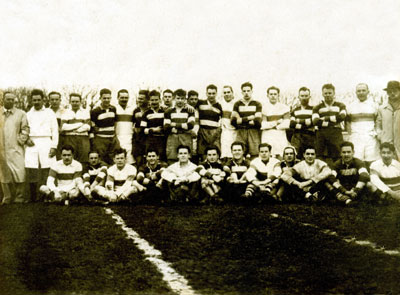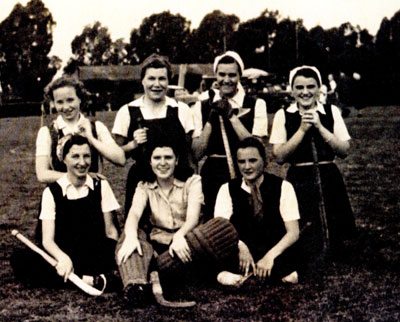|

The Fahy Boys at the
Fahy Institute, c.1928
(Hurling Club collection)
|
The date
of 14 February 1955 was to be an inauspicious one in the
club’s history, when an electrical short circuit caused a
fire that burnt the wooden clubhouse to the ground. Only
part of the locker room was to escape the flames. As a
measure of the standing the club had achieved among the
English-speaking community and indeed the wider community,
there were many acts of solidarity which helped the club
get back on its feet again. Hurlingham Club
[12] provided
a marquee to serve as a hall and a bar and the Círculo de
Villa Devoto sports and social club opened its doors to
members of the Hurling Club so that they could use its
facilities. The Pacific Railway Club organised several
fundraising events to enable the re-building of the
clubhouse. A group of club members who had knowledge of
the construction sector, known as Los Horneros,
[13] led the rebuilding work in what was a significant
voluntary effort.
The
Introduction of Rugby
In early
1941 a group of junior members of the club led by Jimmy
Ussher showed an interest in forming a rugby team in the
Hurling Club. They invited José Daniel Moché to a meeting
to explore the feasibility of taking up rugby. Moché
himself was a former player with the first division at
Olivos Rugby Club, and had a connection to Hurling through
his wife’s family. A nucleus of a team began to practice
the game from mid-1941 onwards under the management of
Moché. To meet the requirements for affiliation to the
Rugby Union of the River Plate, the predecessor of the
current Union of Argentine Rugby (UAR), they needed to
play a number of friendly games against affiliated clubs
before they could formally seek union membership.
Their
first competitive match was held on 17 May 1942 in Villa
Devoto, against Lomas Athletic Club. Hurling’s first try
in competitive rugby was scored by Guillermo ‘Mozo’
MacAllister with Sean Sill making the first conversion.
The visiting team, steeped in a long tradition of rugby,
won 19-5. A second friendly took place two weeks later on
31 May 1942 against St. Andrew’s College in Llavallol,
Lomas de Zamora. As a novice rugby club, Hurling received
much help and assistance from other clubs such as Porteño
Athletic Club (a club which itself was founded mainly by
Irish-Argentines), who allowed them to use their pitch in
Palermo, as the Hurlingham site was still under
development. They later also used the grounds of the
Buenos Aires Cricket and Rugby Club. It would be 1948
before Hurling acquired its own grounds, as mentioned
above. Media support was also forthcoming, in particular
from Hugo Mackern, a freelance journalist who worked for
one of the leading English-language newspapers The
Buenos Aires Herald and the sports magazine El
Gráfico.
|

Rugby Blue vs. White -
Father Fahy Centennary Celebration, 13 September 1943.
(Top
row, left to right): D. Thompson, D. Jack, F. Morrow, D. Kelly,
J. Carmody, D. Fitzpatrick, S. Sills, J. Kelly, F.
Colson, T. McCormack, A. Suarez, S. Shamoun, D.
Farrell, J. Ferro, T. Fitzsimon, J. Laffan, T. Elliot.
(Bottom row): Cromayne, B. Fox, G. MacLoughlin, D. MacLoughlin, E. Shanly,
E. Aguirre, L. Shanly, F. Farrell, A. Geraghty, D.
Lewis, R. Harten, L. McCormack
(Hurling Club collection)
|
Hurling
became an official member of the River Plate Rugby Union
in 1943 and began to compete in the tournament of the
Third Division in the same year. It played its first
official match on the grounds of Porteño Athletic Club on
9 May 1943 against Kangurú Rugby Club, losing by 17-3. In
their first year they came fifth, just behind Obras
Sanitarias. The team included South African Rybeck
Elliott, who had first come to Argentina as part of the
Junior Springboks in 1932.
At that
time in the history of rugby union no substitution of
players was allowed. Not being able to alternate meant
that it would be difficult to develop the talents of the
younger generation of players. Hurling overcame the
problem by joining the Catholic Rugby League (LCR) in
1943, an organisation which ran in parallel to the River
Plate Union. In 1945 Hurling came second in the tournament
organised by the LCR.
The early
1950s was a time of great progress for the club in rugby,
despite the setback of the clubhouse fire. The first
junior team was created in 1953 and later that decade
Hurling made its first tour at the invitation of the
Tucumán institution, Lince Rugby Club, to open their new
playing pitch. It also played another game with a
fledgling team from the city of Concepción, Concepción
Rugby Club, now Huirapuca Rugby Club. By the early 1960s
the Club had started to reap rewards. In 1963 the junior
team were runners-up in the UAR Reserve Division
Championship. This formed the nucleus of the team that
would go on to win the Third Classification in 1966
against Banco Nación, gaining promotion to the third
division of the Ascenso championship. The specialist rugby
magazine Tercer Tiempo devoted significant coverage
of the ascent of Hurling in the world of rugby.
In 1980
the club embarked upon its first major tour abroad,
playing five matches in Ireland and one in England. They
won two matches against Galwegians Rugby Club in Galway
and Malone Rugby Club Belfast, tied a game against
Lansdowne Rugby Club in Dublin and lost three games
against University College Cork, Limerick and Bohemians
Rugby Club in Staines, London.
Excelling in Field Hockey
In June
1930 a notice was published in The Southern Cross,
seeking players interested in playing field hockey for the
Argentine Federation of Hurling, in a move orchestrated by
Mary P. Richards and Tabby Gramática Brown. There was an
enthusiastic response to the call and with the
collaboration of Patrick (Paddy) Gramática Brown - one of
the most famous referees at that time in the sport - a
team christened the Golden Wings began training with a
view to competing in the Women's Hockey League. The club
joined the Argentine Association of Amateur Field Hockey (AAAH)
and the following May made its debut in associations
league against Saint Andrew’s Past Pupils. The team was
quick to make an impact in the sport and some time later
the sports magazine El Gráfico published a photo of
six sisters from the Fox family who played for the Golden
Wings. The ladies team won their First Division
championship in 1958.
|

Hockey seven-a-side,
second division 1948. (Top row, left to right): D. Fox, I. Lang, O. Patridge,
L. Mackinson. (Bottom row): T. Fleming, L. McCormick, R.Mackinson
(Hurling Club collection)
|
Whilst the
motivation of the male club members in adopting hockey is
unclear, one can identify some of the influences involved.
In particular, members were already familiar with the game
through the women’s division ‘Golden Wings’. There was
also likely to have been a feeling among members that they
could excel at the game given their expertise with a
hurley. They began to practice and play friendlies in the
latter part of 1941, and in 1942 they joined the
AAAH and began to compete in its main tournament. Another group
took up rugby.
The first
official male field hockey game played by Hurling Club was
in May 1943 against Quilmes Athletic Club ‘B’ team. They
won the first match by 2-0 and the first goal in
competitive hockey was scored by Cecilio McCormack, who
some years later would become president of the
AAAH. The Standard
newspaper reported that Hurling had committed a number of
unusual offences during the match, including kicking the
ball with their feet. By the end of the first season the
men’s hockey team were crowned champions of the second
division. In their first year in the premier division,
they were unlucky in losing the top spot to Quilmes by a
single goal. Following that, however, Hurling came to
dominate Argentine hockey for the next seven years,
winning the first division championship in 1949, 1950,
1951, 1953, 1954, 1955 and 1956.
Such was
the club’s rise to prominence in the sport that three
forwards and two midfielders were chosen to be part of the
hockey team that competed in the 1948 Summer Olympics in
London. These were Tomás Quinn, Luis Scally, Tomás Scally,
Tomás Wade and Guillermo Dolan. The goalkeeper Mario
Vieytes from the Club was pre-selected, but was
not included in the final list. The team travelled to
London by ship, together with distinguished sportsmen such
as the basketball player Oscar Furlong, and Delfor
Cabrera, winner of the marathon. Their training and
practice sessions were held on the ship’s deck. In their
first group game they lost to India 1-9 (eventual gold
medal winners), won 3-2 against Spain and drew 1-1 with
Austria. Overall they came second in the group, but this
was insufficient to allow them to progress to the
semi-finals. |



